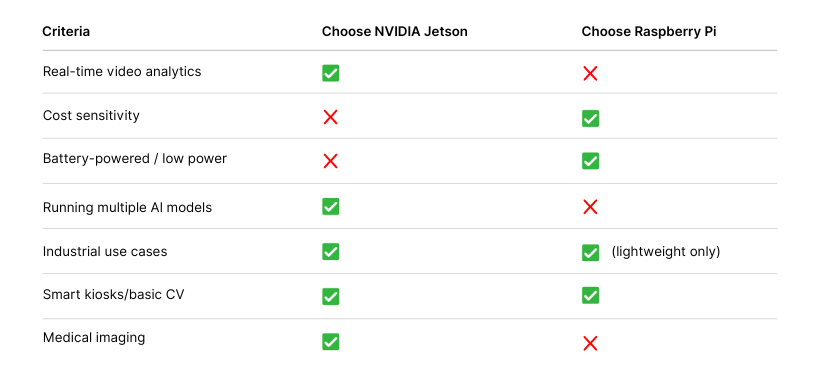Choosing the Right Edge AI Platform: NVIDIA Jetson vs. Raspberry Pi
Choosing the Right Edge AI Platform: NVIDIA Jetson vs. Raspberry Pi
When building Edge AI applications, choosing the right hardware platform can make or break your deployment. Whether you’re processing real-time video streams on a factory floor, analyzing customer behavior in a retail store, or running diagnostics on a wearable device — the underlying edge device must match the performance, power, and cost requirements of your use case.
At GenAI Protos, we help companies across industries make informed decisions between leading edge AI platforms like NVIDIA Jetson and Raspberry Pi, and tailor the full solution stack around them.
Why Hardware Selection Matters
Your edge AI model is only as good as the device it runs on. Considerations like compute capability, sensor integration, cost, power consumption, and environmental constraints can determine whether a deployment succeeds – or stalls in the pilot stage.
We break down the two most popular platforms – NVIDIA Jetson and Raspberry Pi – and when to choose each.
Platform 1: NVIDIA Jetson Family (Nano, Xavier NX, Orin Nano, AGX Orin)
Pros:
- High computational power: Suitable for running real-time computer vision, deep learning models, and multitasking workloads
- GPU acceleration: Optimized for AI inference at the edge with CUDA cores
- Supports multiple sensors: Handles multiple high-res video inputs, LIDAR, depth cameras, etc.
- Rich ecosystem: Compatible with NVIDIA DeepStream, TensorRT, and other AI frameworks
- Robust for production use: Designed for deployment in retail, manufacturing, healthcare, and robotics
Cons:
- Higher cost: Not ideal for ultra-low-budget applications
- More power consumption: Needs thermal management and stable power supply
Best For:
- Manufacturing defect detection systems
- Multi-camera retail analytics
- Drone-based object tracking
- Medical image analysis on-device
Platform 2: Raspberry Pi with AI Add-ons
Pros:
- Cost-effective: Ideal for small-scale pilots or education
- Low power: Can be battery-operated or solar-powered
- Flexible form factor: Easily fits into enclosures or wearable devices
- Vast community support: Easy access to tools and tutorials
Cons:
- Limited processing power: Not suitable for complex models or large-scale video feeds
- May need external accelerators: For heavier AI tasks, requires USB-attached NPUs (like Google Coral, Intel Movidius)
Best For:
- Single-camera footfall monitoring in retail
- Low-resolution visual checks on assembly lines
- Remote health monitoring with lightweight AI
- Smart agriculture with sensor-based predictions
Decision-Making Cheat Sheet

How GenAI Protos Helps You Choose and Deliver
At GenAI Protos, we don’t just pick a board — we build the full edge intelligence stack:
We Help You:
- Define your use case requirements and constraints
- Benchmark performance across platforms
- Optimize models to run on your chosen hardware
- Design sensor integrations and input pipelines
- Build robust deployment and update mechanisms
- Scale across 1 device or 1,000+ with orchestration frameworks
Real Deployments:
- Real-time defect detection with Jetson Orin Nano in high-speed manufacturing
- Shelf monitoring and customer analytics with Jetson Xavier NX in retail stores
- Predictive maintenance on Raspberry Pi for low-cost IoT in energy infrastructure
- Raspberry Pi-based wearable device with embedded anomaly detection for healthcare
The Right Platform = Faster, Smarter Deployment
No single edge AI platform fits every use case. Your hardware should match your vision — and your constraints. Whether you need enterprise-grade power or lean experimentation, we’ll help you select and optimize the right stack for your project.
Ready to Build Your Edge AI Solution?
Let’s make your vision real – at the edge
From pilot to scale, GenAI Protos delivers custom Edge AI systems that work in your environment, with your data, and for your use case.